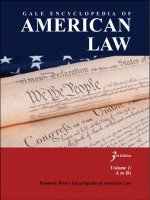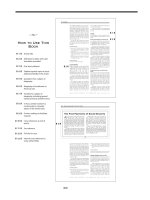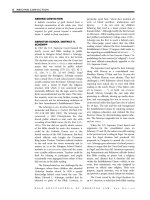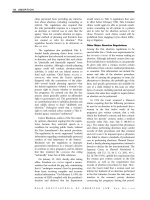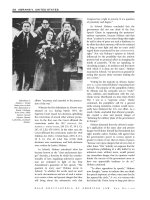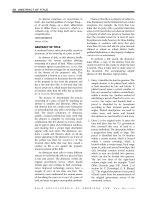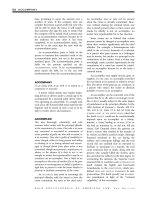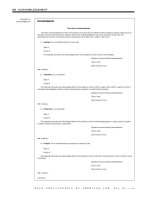Gale Encyclopedia Of American Law 3Rd Edition Volume 1 P34 potx
Bạn đang xem bản rút gọn của tài liệu. Xem và tải ngay bản đầy đủ của tài liệu tại đây (193.17 KB, 10 trang )
restrictive practices and monopoly power.
Although activities such as price-fixing still
came under attack, other kinds of business
cooperation flourished and even received offi-
cial encouragement during the early years of the
NEW DEAL. This pattern lasted for a good 15
years, intensifying after the
STOCK MARKET crash
of 1929.
Following what historians called the era of
neglect, antitrust made a resurgence. In 1935 the
U.S. Supreme Court struck down President
Franklin D. Roosevelt’s National Industrial
Recovery Act, which coordinated industry-wide
output and pricing, in ALA Schechter Poultry
Corp. v. United States, 295 U.S. 495, 55 S. Ct. 837,
79 L. Ed. 1570. The decision radically affected
New Deal–era policy. The fo llowing year, Con-
gress passed the Robinson-Patman Act in an
attempt to make sense of the Clayton Act’s bans
on price discrimination. The Robinson-Patman
Act explicitly forbade forms of price discrimina-
tion, in order to protect small producers from
extinction at the hands of larger competitors. By
1937, economic decline brought federal antitrust
enforcement back with a vengeance, as Roose-
velt’s administration began an extensive investi-
gation into monopolies. The effort resulted in
more than 80 antitrust suits in 1940 alone.
One federal court case in this period, United
States v. Aluminum Co. of America, 148 F.2d 416
(2d Cir. 1945) (Alcoa), changed antimonopoly
law for years to come. Since the 1920s, the U.S.
Supreme Court had looked skeptically on the role
of a business’s size in judging monopoly cases. In
United States v. United States Steel Corp., 251 U.S.
417, 40 S. Ct. 293, 64 L. Ed. 343 (1920), it said,
“[T]he law does not make mere size an offense, or
the existence of unexerted power an offense. It,
we repeat, requires overt acts.” The decision
weakened the monopoly ban of the Sherman Act.
Rather than focus on abusive business conduct,
Alcoa emphasized the role of market power.
Judge Learned Hand wrote for the Court: “Many
people believe that possession of unchallenged
economic power deadens initiative, discourages
thrift and depresses energy; that immunity from
competition is a narcotic, and rivalry is a
stimulant, to industrial progress; that the spur
of constant stress is necessary to counteract an
inevitable disposition to let well enough alone.”
The standard that emerged from this decision
applied a two-part test for determining illegal
monopolization: The
DEFENDANT (1) must possess
monopoly power in a relevant market; and (2)
must have improperly used exclusionary acts to
gain or protect that power.
Congress added its last piece of important
legislation in 1950 with the Celler-Kefauver
Antimerger Act, addressing a weakness in the
Clayton Act. Because only anticompetitive stock
purchases had been forbidden, businesses
would circumvent the Clayton Act by targeting
the assets of their rivals. U.S. Supreme Court
decisions had also undermined the law by
allowing businesses to transfer stock purchases
into assets before the government filed a
complaint. The Celler-Kefauver amendment
closed these loopholes.
The U.S. Supreme Court and
Evolving Doctrine
Vigorous enforcement of antitrust legislation
created an immense bo dy of
CASE LAW. After 1950,
U.S. Supreme Court decisions did more than
anything else to shape antitrust doctrine. Two
competing outlooks emerged. One regarded
markets as fragile, easily distorted by private firms,
and readily correctable through public interven-
tion. E conomic efficiency mat tered less, in this
view, th an the belief in the antitrust doctrine’s
ability to meet social andpolitical goals. Opponents
saw business rivalry as being generally healthy.
They doubted that public intervention could cure
defects, and they emphasized the self-correcting
ability o f markets to erode private restraints and
private power. This outlook opposed the use of
antitrust measures except to stop behavior that
clearly harms the e fficien cy of bu siness .
The most aggressive doctrine was developed
under Chief Justice
EARL WARREN. The WARREN
COURT
often saw the need for decentralized social,
political, and economic power, a goal that it put
ahead of the ideal of economic efficiency. In
1962, its first ruling on the Celler-Kefauver Act,
Brown Shoe Co. v. United States, 370 U.S. 294, 82
S. Ct. 1502, 8 L. Ed. 2d 510, held that a merger
between two firms that accounted for only 5
percent of total industry output violated the
principal antimerger provision of the antitrust
laws. Brown Shoe also reflected the Court’s
hostility toward vertical restraints (i.e., restric-
tions imposed in contracts by the seller on the
buyer, or
VICE versa) at that time.
This aggressive approach peaked in 1967 in
United States v. Arnold, Schwinn & Co., 388 U.S.
365, 87 S. Ct. 1856, 18 L. Ed. 2d 1249. Arnold
GALE ENCYCLOPEDIA OF AMERICAN LAW, 3RD E DITION
318 ANTITRUST LAW
concerned nonprice vertical restraints (i.e., terri-
torial or customer restrictions on the resale of
goods). The majority ruled that such restraints
were per se illegal, in other words, so harmful to
competition that they need not be evaluated. In
ensuing years, respected antitrust experts, such
as Chief Judge
RICHARD POSNER of the U.S. Court
of Appeals for the 7th Circuit, criticized the
Court’s use of “ per se” tests to invalidate vertical
price agreements between competitors or be-
tween sellers and buyers, arguing that such
agreements can be efficient.
The U.S. Supreme Court heeded this
criticism in State Oil Co. v. Khan, 522 U.S. 3,
118 S. Ct. 275, 139 L. Ed. 2d 199 (U.S. 1997).
Relying heavily on an appellate opinion penned
by Judge Posner, the high co urt overruled a 29-
year-old precedent that declared all vertical
maximum price-fixing arrangements to be per
se violations of the Sherman Act. Vertical
maximum price-fixing arrangements, like the
majority of commercial arrangements that are
subject to antitrust laws, should be evaluated
under the rule of reason, the Court wrote. The
rule-of-reason analysis will effectively identify
those situations in which vertical maximum
price-fixing amounts to anticompetitive con-
duct, by allowing courts to evaluate a variety of
factors, according to the Court. These factors
include specific information about the relevant
business; the condition of the business before
and after the restraint was imposed; and the
history, nature, and effect of the restraint.
By the mid 1970s the U.S. Court backed off
its robust interventionism. Two pivotal decisions
came in 1977, including the most important
since
WORLD WAR II, Continental TV v. GTE
Sylvania, 433 U.S. 36, 97 S. Ct. 2549, 53 L. Ed. 2d
568. In a decisive departure from the previous
decade’s rulings, the Court abandoned its
hostility toward efficiency. Now, for evaluating
nonprice vertical restraints, it returned to the use
of a rule of reason. Per se rules would remain
influential, but economic analysis would be the
primary tool in formulating and applying
antitrust rules. The second powerful change in
doctrine was Brunswick Corp. v. Pueblo Bowl-O-
Mat, 429 U.S. 477, 97 S. Ct. 690, 50 L. Ed. 2d 701.
In the Brunswick decision, the Court wrote that
antitrust laws “were enacted for the ‘protection
of competition, not competitors.’” The irony was
addressed to private antitrust litigants. If they
wanted to
SUE, the Court wrote, they would have
to prove “antitrust injury.” This decision dis-
carded the old view that the demise of individual
firms was plainly bad for competition. Replacing
it was the view that adverse effects to businesses
are sometimes offset by gains in reduced costs
and increased output. Increasingly, after Bruns-
wick, the U.S. Supre me Court and lower courts
accepted economic efficien cy as a justification
for dominant firms to defend their market
positions. By 1986 efficiency-based analysis was
widely accepted in federal courts.
Even against this restrictive background,
explosive change occurred. The early 1980s saw
the dramatic conclusion of a historic monopoly
case against the telephone giant American
Telephone and Telegraph (AT&T) (United States
v. American Telephone & Telegraph Co., 552 F.
Supp. 131 [D.D.C. 1982], aff’d in Maryland v.
United States, 460 U.S. 1001, 103 S. Ct. 1240, 75 L.
Ed. 2d 472 [1983]). DOJ settled claims that AT&T
had impeded competition in long-distance
telephone service and telecommunications
equipment. The result was the largest divestiture
in history: A federal court severed the Bell
System’s operating companie s and manufactur-
ing arm (Western Electric) from AT&T, thus
transforming the nation’s telephone services. But
the historic settlement was an exception to the
political philosophy and the level of enforcement
that characterized the decade. As the 1980s were
ending, the DOJ dropped its 13-year suit against
International Business Machines (IBM). This
lengthy battle had sought to end IBM’s domi-
nance by breaking it up into four computer
companies. Convinced that market forces had
done the work for them, prosecutors gave up.
Throughout the 1980s, political conservatism
in federal enforcement complemented the U.S.
Supreme Court’s doctrine of non-intervention.
The administration of President
RONALD REAGAN
reduced the budgets of the FTC and the DOJ,
leaving them with limited resources for enforce-
ment. Enforcement efforts followed a restrictive
agenda of prosecuting cases of output restrictions
and large mergers of a horizontal nature (i.e.,
those involving firms within the same industry
and at the same level of production). Mergers of
companies into conglomerates, by contrast, were
looked on favorably, and the years 1984 and 1985
produced the greatest increase in corporate
acquisitions in the nation’s history.
As the U.S. Supreme Court strengthened
requirements for evidence, injury, and the right
GALE ENCYCLOPEDIA OF AMERICAN LAW, 3RD E DITION
ANTITRUST LAW 319
to bring suit, antitrust cases became harder for
plaintiffs to win. Most decisions during this
period narrowed the reach of antitrust. A few
rare exceptions, such as Aspen Skiing Co. v.
Aspen Highlands Skiing Corp., 472 U.S. 585, 105
S. Ct. 2847, 86 L. Ed. 2d 467 (1985), which
condemned a monopolist’s unjustified refusal
to deal with a rival, faintly recalled the tough
outlook of the Warren Court. Non-intervention,
however, took precedence. In the strongest
example, Matsushita Electrical Industrial Co.
v. Zenith Radio Corp., 475 U.S. 574, 106 S. Ct.
1348, 89 L. Ed. 2d 538 (1986), the majority
dismissed allegations that Japanese television
manufacturers had engaged in a 20-year pricing
conspiracy that was designed to drive U.S.
electronics equipment manufacturers out of
business. The Court discouraged claims that
rested on ambiguous
CIRCUMSTANTIAL EVIDENCE or
lacked “economic rationality,” suggesting that
lower courts settle these by
SUMMARY JUDGMENT.
Litigation since the 1980s
Once again proving that antitrust law never
remains static, the late 1980s and early 1990s
brought more changes in enforcement, eco-
nomic analysis, and court doctrine. At the state
level in the late 1980s, governments attacked
mergers and restraints. The U.S. Supreme Court
gave these efforts support in California v.
American Stores Co., 495 U.S. 271, 110 S. Ct.
1853, 109 L. Ed. 2d 240 (1990), upholding the
ability of state governments to break up illegal
mergers. Another trend came again from
academia, where for years critics of the Chicago
School had been re-evaluating its highly influ-
ential efficiency model. They concluded that a
proper analysis of efficiency goals showed that
efficiency demanded tighter antitrust contro ls,
not stubborn non-interven tion.
An important 1992 U.S. Supreme Court
case seemed to support this view. Eastman
Kodak Co. v. Image Technical Services, 504 U.S.
451, 112 S. Ct. 2072, 119 L. Ed. 2d 265
(hereinafter Kodak), concerned tying arrange-
ments (i.e., contracts between buyer and seller
that restrict competition) in the sale and service
of photocopiers. Kodak sold replacement parts
only to buyers who agreed to have Kodak
exclusively service the machines, and the
restriction prompted a lawsuit from 18 inde-
pendent service organizations (ISOs). The
company defended itself by arguing that even
if it did monopolize the market, it lacked the
necessary market power for a Sherman Act
violation. The Court rejected the idea that this
was enough to create a legal rule that equipment
competition precluded any finding of monopoly
power in the parts and services industry. In
declaring Kodak’s arrangement to be illegal,
Justice
HARRY A. BLACKMUN warned about the
dangers of relying on economic theory as a
substitute for “actual market realities”—in this
case, the harm done to ISOs who were shut out
of the service market.
After the Reagan years, antitrust attitudes
sharpened in Washington, D.C. The adminis-
tration of President George H. W. Bush adopted
a slightly more activist approach, which was
reflected in joint guidelines on mergers, issued
in 1992 by the FTC and DOJ. In following the
trend away from strict Chicago School efficiency
standards, the guidelines looked more closely at
competitive effects and tightened requirements.
But understaffed government attorneys generally
lost court cases. President
BILL CLINTON took this
activism further. Anne K. Bingaman, his appoin-
tee to head DOJ’s Antitrust Division, strength-
ened the division’s staff with 61 new attorneys,
declaring her organization to be the competition
agency. The Antitrust Division filed 33 civil suits
in 1994, roughly three times the annual number
that had been brought under Reagan and Bush.
It won some victories without going to court, in
one instance compelling AT&T to keep a
subsidiary private, but it lost a major lawsuit in
which it had claimed that General Electric had
conspired with the South African firm of
DeBeers to fix industrial diamond prices.
Congress continued to address monopolies
in legislation passed during the 1990s. Congress
passed the Telecommunications Act of 1996,
Pub. L. No. 104-104, 110 Stat. 56, to increase
competition within the telecommunications
industry and to end state-sanctioned monopo-
lies. The act required regional telephone compa-
nies (known as the Baby Bells) to share their
networks with a new generation of telecommu-
nications companies. Dozens of new companies
began as a result of the 1996 act, and disputes
emerged. During the early 2000s,
LITIGATION arose
accusing a local exchange carrier, Verizon
Communications, of violating the antitrust
provisions of the Sherman Act. The Supreme
Court, however, determined that these types of
claims did not fall under the Sherman Act
GALE ENCYCLOPEDIA OF AMERICAN LAW, 3RD E DITION
320 ANTITRUST LAW
(Verizon Communications, Inc v. Law Offices of
Curtis V. Trinko, 540 U.S. 398, 124 S. Ct. 872, 157
L. Ed. 823 [2004]).
Under President Clinton, the most impor-
tant antitrust actions involved federal probes of
the computer microprocessor giant Intel Cor-
poration and the computer software giant
Microsoft Corporation. In 1999 the FTC settled
a year-old la wsuit against Intel by entering a
CONSENT DECREE under which Intel agreed to
cease retaliating against customers during
INTELLECTUAL PROPERTY disputes over micropro-
cessor technology. In its 1998 lawsuit, the FTC
claimed that Intel had illegally cut off shipments
of its microprocessor chips and withheld
technical information regarding microproces-
sors, to coerce its competitors (Intergraph
Corp., the forme r Digital Equipment Corp.,
and Compaq Computer Corp., which acquired
Digital in 1998) to give up their microprocessor
technology. Intel did not dispute most of the
facts underlying the allegations, but it insisted
that it had acted legally.
However, the Microsoft probe, in its poten-
tial for far-reaching action, was the biggest
antitrust case since those involving AT&T and
IBM. Competitors complained that Microsoft
had been using illegal arrangements with buyers
to ensure that its Windows operating system
would be installe d in nearly 80 percent of the
world’s computers. In-depth investigations by
the FTC and DOJ followed. In July 1994, under
threat of a federal lawsuit, Microsoft entered a
consent decree that was designed to increase
competitors’ access to the market. The follow-
ing year, Microsoft launched its popular
Windows 95 operating system with an upgraded
version of its
INTERNET Explorer Web browser,
two products that the software maker said were
integrally related.
Over the next two years, the federal govern-
ment received fresh complaints that Microsoft
was again resorting to anti-com petitive practices.
The DOJ responded by suing Microsoft in the
U.S. district court for the District of Columbia,
alleging that the software maker had violated the
1994 consent decree by forcing computer
makers to install its Internet Explorer Web
browser as a pre-condition to the computer
makers having the right to sell their PCs with the
Windows 95 operating system included. Two
months later U.S. District Judge Thomas Pen-
field Jackson issued a
PRELIMINARY INJUNCTION
forcing Microsoft to stop, at least temporarily ,
requiring manufacturers who sell the Windows
operating system to install Microsoft’s Internet
Explorer, an arrangement that he called an illegal
tying agreement (United States. v. Microsoft
Corp., 980 F. Supp. 537 [D.D.C. 1997]). Fueled
in part by Jackson’s ruling, the DOJ joined 20
state attorneys general in May 1998 to bring suit
against Microsoft, charging that the software
maker’s illegal bundling of Internet Explorer
with Windows 95 violated federal antitrust laws
and state unfair-competition statutes. The fol-
lowing month, a three-judge panel for the U.S
Court of Appeals for the District of Columbia
overturned the preliminary injunction that
Judge Jackso n had issued to enforce the consent
decree, thus making way for the parties to resolve
their dispute in the joint suit brought by DOJ
and the state attorneys general (United States v.
Microsoft Corp., 147 F.3d 935 [D.C. Cir. 1998]).
On October 19, 1998, trial began in the
antitrust suit against Microsoft. Less than a
month later, Judge Jackson had issued a
preliminary finding that Microsoft was exercis-
ing illegal monopoly power in the operating-
system market and that the software maker had
been using that power to promote its Web
browser and to stifle competition through illegal
bundling of the two products (United States v.
Microsoft Corp., 84 F.Supp.2d 9 [D.D.C. 1999]).
Jackson issued his
FINAL DECISION in April 2000.
The judge reiterated his preliminary findings
and also concluded that the same facts that
demonstrated that Microsoft had unlawfully
leveraged its operating-system monopoly to
push rival Web browsers out of the market in
violation of federal law also established Micro-
soft’s liability under analogous state antitrust
provisions (United States v. Microsoft Corp.,97
F. Supp. 2d 59 [D.D.C. 2000]).
Later that month, the court proceeded to
the remedy phase of the trial. DOJ and 18 state
attorneys general (two attorneys general had
since dropped out of the suit) asked the judge to
break the company into two parts: one com-
pany to develop and market the Windows
operating system, and the other to develop
Microsoft’s software, including its Web browser.
On June 7, 2000, Judge Jackson granted the
requested remedy, and Microsoft appealed. The
court of appeals reversed, finding that Jackson
had erroneously applied a per se analyses in
making his findings instead of the appropriate
GALE ENCYCLOPEDIA OF AMERICAN LAW, 3RD E DITION
ANTITRUST LAW 321
“rule of reason” standard (United States v.
Microsoft Corp., 253 F.3d 34 [D.C. Cir. 2001]).
The appellate court then remanded the matter
for further proceedings, but ordered Judge
Jackson removed from the case after he made
extra-judicial comments to the press in violation
of ethical canons forbidding judges from com-
menting on the merits of a pending case. Upon
remand, Judge Colleen Kollar-Kotelly was se-
lected to replace Jackson.
In September 2001 the DOJ announced that
it would no longer seek a breakup of Microsoft
and agreed to commence negotiations to settle
the lawsuit. Those negotiations bore fruit in
October 2001, when the DOJ and nine states
announced that they had reached a tentative
settlement with Microsoft. Ultimately approved
by Judge Kollar-Kotelly on November 1, 2002,
the settlement prevents Microsoft from parti-
cipating in exclusive deals that could hurt
competitors; requires Microsoft to offer uni-
form contract terms to PC makers; and obliges
the so ftware giant to release some technical
information so that software developers can
write programs fo r Windows that work as well
as Microsoft’s own products do. The settlement
agreement also compels Microsoft to give
manufacturers and customers a way to remove
certain Micr osoft icons from the Windows
desktop. In the court’s order approving the
settlement, the judge expressly reserved the
right to reopen the case herself if she ever
suspects Microsoft of violating the settlement’s
terms United States v. Microsoft, 231 F. Supp. 2d
144 [D.D.C. 2002]). To demonstrate its
GOOD
FAITH
, Microsoft immediately unveiled several
business and product changes to comply with
the settlement, includin g Windows functionali-
ty that gives users the ability to hide Microsoft
programs like its Web browser and only see
competing products.
In the early 2000s the Supreme Court was
called upon several times to review provisions of
the federal antitrust statutes. For instance, in
Leegin Creative Leather Products v. PSKS, 551
U.S. 877, 127 S. Ct. 2705, 168 L. Ed. 2d 623
(2007), the Court reviewed a case involving
vertical price restraints. In 1911 the Court had
reviewed these types of restraints and concluded
that the restraints were per se violations of the
Sherman Act (Dr. Miles Medical Co. v. John D.
Park & Sons Co., 220 U.S. 373, 31 S. Ct. 376, 55
L. Ed. 502). In Leegin Creative Leather Products,
the Court concluded that the rule of reason
should govern these types of restraints.
FURTHER READINGS
American Bar Association, Section of Antitrust Law. 2008.
State Antitrust Enforcement Handbook. 2d ed. Chicago:
American Bar Association, Section of Antitrust Law.
Dabbah, Maher M. 2003. The Internationalisation of
Antitrust Policy. New York: Cambridge Univ. Press.
Evans, David S., ed. 2002. Microsoft, Antitrust and the New
Economy: Selected Essays. Boston: Kluwer Academic.
Fundamentals of Antitrust Law (serial). New York: Aspen
Law & Business.
Hylton, Keith N. 2003. Antitrust Law: Economic Theory and
Common Law. New York: Cambridge Univ. Press.
Posner, Richard A. 2001. Antitrust Law. 2d ed. Chicago:
Univ. of Chicago Press.
CROSS REFERENCES
Bork, Robert; Chicago School; Clayton Act; Corporations;
Justice Department; Mergers and Acquisitions; Monopoly;
Posner, Richard Allen; Restraint of Trade; Robinson-
Patman Act; Sherman Anti-Trust Act; Unfair Competition.
APPARENT
That which is clear, plain, and evident.
In the law of agency, an agent has apparent
authority to represent the person, or principal,
for whom he or she acts, when the principal acts
in such a manner toward the agent that a
REASONABLE PERSON would plainly assume that the
agent was acting for the principal.
APPEAL
Timely resort by an unsuccessful party in a lawsuit
or administrative proceeding to an appropriate
superior court empowered to review a final
decision on the ground that it was based upon
an erroneous application of law.
A person who initiates an appeal—the
appellant, sometimes called the
PLAINTIFF IN ERROR,
must file a notice of appeal, along with the
necessary documents, to commence appellate
review. The person against whom the appeal is
brought, the appellee, then files a brief in
response to the appellant’s allegations.
There are usually two stages of review in the
federal court and in many state court systems:
an appeal from a trial court to an intermediate
appellate court and thereafter to the highest
appellate court in the jurisdiction. Within the
appellate rules of administrative procedure,
there might be several levels of appeals from a
determination made by an administrative agency.
For example, an appeal of the decision of an
GALE ENCYCLOPEDIA OF AMERICAN LAW, 3RD E DITION
322 APPARENT
administrative law judge may be heard by a
reviewing body within the agency, and from that
body, the appeal may go to a trial court, such as a
federal district court. Thereafter, the appeal
might travel the same route as an appeal taken
from a judicial decision, going from an interme-
diate to a superior appellate court, or it might go
directly to a superior appellate court for review,
bypassing the intermediate stage. The rules of
appellate procedure applicable to a particular
court govern its review of cases.
Right to Appeal
There is no absolute right of appeal for all
decisions rendered by a lower court or admin-
istrative agency. Federal and state constitutions
and statutory provisions create appellate courts
and prescribe the types of cases that are within
their jurisdiction. An appeal may be granted as a
matter of right, such as from a trial court to an
intermediate appellate court or only at the
discretion of a superior appellate court, for
example, by a grant of
CERTIORARI by the
Supreme Court. If the decision presented does
not meet the statutory requirements for review,
the appellat e court is powerless to hear the
appeal and review is denied.
The right to appeal a decision is limited to
those parties to the proceeding who are aggrieved
by the decision because it has a direct and adverse
effect upon their persons or property. In addi-
tion, an actual
CASE OR CONTROVERSY must exist at
the time of review. Issues that have become
MOOT
while the appeal is pending and cases that have
been settled during that time are not reviewable.
Final Decision
A final judgment or order must have been
reached by the trial court in order for a case to
be appealable. A judgment is considered final
for purposes of appeal when it ends the action
in the court in which it was brought and
nothing more is to be decided. This rule is
intended to prevent the piecemeal
LITIGATION of
a lawsuit, to avoid delay resulting from
INTERLOCUTORY appeals, and to give the trial
court the opportunity to render a decision in
the case to the satisfaction of both parties,
thereby obviating the need for appeal. The
consideration of
INCIDENTAL matters, such as the
computation of interest, attorneys’ fees, or court
costs, does not prevent a judgment or order
from being appealed.
Grounds
Error is the basis for review of a FINAL DECISION
rendered by a court or administrative agency.
Error is called to the attention of a court
through the use of objections, protests made
during the course of a proceeding that an action
taken by the opposing side in a controversy is
unfair or illegal. Decisions rendered in favor of
one party at trial level are presumed by an
appellate court to be correct unless objections
have been made to the issues in question during
the trial. Failure to do so will preclude their
review on appeal. An objection must be made as
promptly and specifically as possible for each
act to which it is directed so that the court may
make an intelligent decision regarding its
merits. The trial judge rules on the objection,
and the decision is included in the trial record.
If the attorney for either party disagrees with the
ruling, he or she may take an exception, an
objection taken to a decision of a court on a
MATTER OF LAW, which is noted in the trial record
to be preserved for purposes of appeal. Appel-
late jurisdiction is limited only to a review of
actions taken by an
INFERIOR COURT. No new
objections can be raised before an appellate
Criminal Appeals from U.S. District Courts Filed in U.S. Court of
Appeals, 1998 to 2007
SOURCE: U.S. Court of Appeals, 2007 Judicial Facts and Figures.
0
10,000
12,000 14,000 16,000 18,000
Number of appeals
Year
2007
2006
2005
2004
2003
2002
2001
2000
1999
1998
13,167
15,246
16,060
12,506
11,968
11,569
11,281
10,707
10,251
10,535
ILLUSTRATION BY GGS
CREATIVE RESOURCES.
REPRODUCED BY
PERMISSION OF GALE,
A PART OF CENGAGE
LEARNING.
GALE ENCYCLOPEDIA OF AMERICAN LAW, 3
RD E DITION
APPEAL 323
court for its consideration unless exceptional
circumstances exist to justify the appellate court
raising the issues
SUA SPONTE, on its own motion.
Exceptional circumstances mean the presence
at trial of plain error, a mistake in the
proceedings that substantially affects the rights
of the party against whom the decision has been
made and undermines the fairness and integrity
of the judicial system, causing a
MISCARRIAGE OF
JUSTICE
.
Time of Appeal
Appeals must be made within the time
prescribed by statute or by the governing rules
of the appellate court. Such statutes begin to run
only after a final decision has been made. The
timely filing of the notice of appeal with
the clerk of the appellate court and the appellee
completes, or perfects, the procedure. If the
appeal is not taken and perfected within
the time set by statute, the right to appeal is
foreclosed. Extensions of time for the filing of
an appeal may be granted, however, if
EXTENU-
ATING CIRCUMSTANCES
exist, such as if either party
is adjudicated incompetent or dies.
Notice of Appeal
A notice of appeal—a written document filed by
the appellant with the court and a copy of which
is sent to the appellee—is the initial step in the
appeals process. It informs the court and the
party in whose favor a judgment or order has
been made that the unsuccessful party seeks a
review of the case. Failure to file a notice of
appeal according to the statutory requirements
will preclude appeal.
Bonds
An appeal bond, a promise to pay a sum of
money, must often be posted by an appellant to
secure the appellee against the costs of the
appeal, if the appellee is successful and the
appellant fails to pay. Its amount is determined
by the court itself or by statute. The imposition
of such a bond discourages frivolous appeals. If
successive appeals are taken from an intermedi-
ate appellate court to a superior one, a new
bond is usually req uired.
Record on Appeal
The function of the appellate court is limited to
a review of the trial record sent up from the
lower court and the briefs filed by the appellant
and appellee.
AMICUS CURIAE briefs, if permitted
by the appellate court, also become part of the
record on appeal. The trial record, sometime s
called the record proper, must show the
pleadings that initiated the case, the complete
transcript (in cases of jury trial) of lower court
proceedings, the
VERDICT, and the ENTRY of the
final judgment or order. The appellant must
clearly demonstrate that the grounds for review
had been raised and unsuccessfully decided
upon at the trial level and, therefore, prejudicial
error exists to warrant the reversal of the
decision of the lower court.
In some jurisdictions, a bill of exceptions—a
written statement of the objections made by a
party to the ruling, decision, charge, or opinion
of the trial judge—must be subm itted to the
appellate court to provide a history of the trial
proceedings. It should not include matters that
belong in the record proper but, instead, should
state those points concerning questions of law
raised by the exceptions taken during the trial.
The appellant’s attorney prepares the bill and
presents it to the trial judge for settlement, an
agreement between the trial judge and the
appellant that the bill contains a truthful
account of the events of the trial. If there is
disagreement, the judge returns the bill to the
appellant with an explanation. The appellee
must be given notice of the time and place of
the settlement of the bill of exceptions in order
to object to or approve its contents. The settled
bill of exceptions becomes part of the trial
transcript, which is part of the record on appeal.
The appellant must submit a complete un-
abridged transcript of the trial that is prepared
by the clerk of the trial court.
The entire trial record is printed and filed
with the appellate court, and a copy is also sent
to the appellee.
Assignment of Errors
A statement by the appellant of the errors
alleged to have been committed in the lower
court is an assignment of errors, a type of
appellate
PLEADING used to point out to the
appellate court the grounds for review. It
controls the scope of an appeal because if a
ground for review is not contained in it, it will
not ordinarily be considered by the court. The
assignment of errors is usually part of the notice
of appeal, the bill of exceptions, the transcript of
the record, or the brief, although in some
jurisdictions, it is a separate document.
GALE ENCYCLOPEDIA OF AMERICAN LAW, 3RD E DITION
324 APPEAL
Appellate Brief
The appellant and appellee must file individual
briefs to aid the appellat e court in its consider-
ation of the issues presented. Failure to do so
results in a dismissal of the appeal. The facts of
the case, the grounds for review , and the
arguments relating to those questions must be
concisely stated. Any statements referring to the
trial record must be supported by an appropri-
ate reference to it.
The appellant’s brief must specifically dis-
cuss the alleged errors that entitle the appellant
to a reversal and discuss why each ruling of the
lower court was wrong, citing authority, such as
a case in which a similar point of law has been
decided or a statute that applies to the particular
point in issue. Disrespectful or abusive language
directed against the lower court, the appellate
court, the parties,
WITNESSES, or opposing
counsel cannot be used. If it is, it will be
stricken from the brief, and the costs of the brief
that might have been awarded are disallowed.
Review
Appellate courts have jurisdiction to decide only
issues actually before them on appeal and
nothing else. They cannot render opinions on
controversies or declare principles of law that
have no practical effect in settling the rights of
the litigants.
Only conclusions of law, not findings of fact
made by a lower court, are reviewable.
Harmless Error The appellate court must
decide whether the errors alleged to have been
made by the trial court are harmless or
prejudicial. An error that substantially injures
the rights of one party is called a prejudicial or
reversible error and warrants the reversal of the
final judgment or order. However, an error that
is technical or minimally affects the rights of the
parties or the outcome of the lawsuit is
considered a
HARMLESS ERROR, insufficient to
require a reversal or modification of the
decision of the lower court.
Hearing
The clerk of the appellate court schedules on the
court calendar the date of the hearing on which
each side may present an oral argument. Oral
arguments, usually ten to fifteen minutes for
each side, help the court understand the issues
argued in the brief and persuade the court to
rule in favor of the arguing party. During the
arguments of appellant and appellee, it is not
unusual for the appellate judge to interrupt
with questions on particular issues or points
of law.
The appellant’s argument briefly discusses
the facts on which the
CAUSE OF ACTION is based
and traces the history of the case through the
lower courts. It includes the legal issues raised
by the exceptions taken to the allegedly errone-
ous rulings of the trial judge. Thereafter, the
appellee’s counsel presents arg uments in favor
of affirming the original decision.
Determination
An appellate court has broad powers over the
scope of its decision and the relief to be granted.
After reviewing the controlling issues in an
action, it may affirm the decision of the inferior
tribunal, modify it, reverse it, or remand the
case for a new trial in the lower court pursuant
to its order.
When a decision is affirmed, the appellate
court accepts the decision of the lower court
and rejects the appellant’s contention that it was
erroneously made. The modification of a
decision by an appellate court means that, while
it accepts part of the trial court’s decision, the
appellant was correct that the decision was
partly erroneous. The trial court’s decision is
then modified accordingly.
A reversal of a decision means that the
appellate court agrees with the appellant that
the decision was erroneously made. The party
who lost the case at the trial level becomes the
winning party in appellate court.
In some cases, a decision might be reversed
but the lawsuit is still unresolved. The appellate
court then orders the reversal with the direction
that the case be remanded to a lower court for
the determination of the issues that remain
unsettled.
If a judgment or order is reversed in an
intermediate appellate court, the losing party
may file an appeal with a superior appellate
court for relief, and the appellate process begins
again. The decision rendered by a superior
appellate court cannot ordinarily be reviewed.
In state cases involving issues based on federal
statutes or the Constitution, however, an appeal
may be brought in the federal court system on
those questions that are within its jurisdiction.
GALE ENCYCLOPEDIA OF AMERICAN LAW, 3RD E DITION
APPEAL 325
FURTHER READINGS
Lynn, Richardson R. 1993. Appellate Litigation. 2d ed.
Maryland: Austin & Winfield.
Magen, Barbara S. 2003. “Let’s Twist Again: Getting
Reargument and Reconsideration on Appeal.” Pennsyl-
vania Law Weekly 26 (April).
Wood, Jefri. 2002. Guideline Sentencing: An Outline of
Appellate Case Law on Selected Issues. Washington, D.C.:
Federal Judicial Center.
CROSS REFERENCES
Appellate Advocacy; Appellate Court; Federal Courts;
Remand.
APPEAR
To come before a court as a party or a witness in a
lawsuit.
APPEARANCE
A coming into court by a party to a suit, either in
person or through an attorney, whether as plaintiff
or defendant. The formal proceeding by which a
defendant submits to the jurisdiction of the court.
The voluntary submission to a court’s jurisdiction.
In a criminal prosecution, an appearance is
the initial court proceeding in which a
DEFENDANT
is first brought before a judge. The conduct of an
appearance is governed by state and federal rules
of
CRIMINAL PROCEDURE. The rules vary from state
to state, but they are generally consistent. During
an appearance, the judge advises the defendant of
the charges and of the defendant’s rights,
considers bail or other conditions of release,
and schedules a
PRELIMINARY HEARING. If the crime
charged is a
MISDEMEANOR, the defendant may
sometimes, depending on the local rules of court,
enter a
PLEA of guilty or not guilty at the initial
appearance; if the crime is a FELONY, the
defendant usually enters the plea at a later court
proceeding. A criminal defendant may have an
attorney present and may confer with the
attorney during the appearance.
In some situations, a defendant may not need
to appear in court in person and may even make
an appearance by mail. For example, when
individuals receive traffic tickets they may choose
to send in a check for the amount of the fine.
Many state statutes permit appearances to
be made by two-way, closed-circuit television.
For instance, North Carolina’s rule on video
appearances reads:
A first appearance in a noncapital case may
be conducted by an audio and video
transmission between the judge and
defendant in which the parties can see and
hear each other. If the defendant has counsel,
the defendant shall be allowed to communi-
cate fully and confidentially with his attorney
during the proceeding (N.C. Gen. Stat. §
15A-601(a1) [1994]).
An appearance is also a coming into court as
a party to a civil lawsuit. Although an appear-
ance can be made by either the
PLAINTIFF (the
one who has sued) or the defendant (the one
being sued), the term most often refers to the
action of the defendant.
The subject of appearance is closely related
to the subject of
PERSONAL JURISDICTION, which is
the court’s authority over an individual party.
An appearance is some
OVERT ACT by which the
defendant comes before the court to either
submit to or challenge the court’s jurisdiction.
Any party can appear either in person or
through an attorney or a duly authorized
representative; the party need not be physically
present. In most instances, an attorney makes the
appearance. An appearance can also be made by
filing a notice of appearance with the clerk of
the court and the plaintiff, which states that the
defendant will either submit to the authority of
the court or challenge its jurisdiction. In a lawsuit
involving multiple defendants, an appearance by
one is not an appearance for the others. Valid
SERVICE OF PROCESS is not required before an
appearance can be made.
Historically, appearances have been classified
with a variety of names indicating their manner
or significance. A compulsory appearance is
compelled by process served on the party. A
conditional appearance is coupled with condi-
tions as to its becoming or being taken as a
GENERAL APPEARANCE (defined later in this article).
A corporal appearance indicates that the person is
physically present in court. A de bene esse (Latin,
“of well being,” sufficient for the present)
appearance is provisional and will remain good
only upon a future contingency. A gratis (Latin,
“free” or “freely”) appearance is made by a party
to the action before the service of any process or
legal notice to appear. An optional appearance is
entered by a person who is intervening in the
action to protect his or her own interests, though
not joined as a party. A subsequent appearance is
made by a defendant after an appearance has
already been entered for him or her by the
plaintiff. Finally, a voluntary appearance is
entered by a party’s own will or consent, without
GALE ENCYCLOPEDIA OF AMERICAN LAW, 3RD E DITION
326 APPEAR
service of process, although process might be
outstanding.
The two most common categories of
appearances are general and special.
General Appearance
Any action by which the defendant recognizes
the jurisdiction of the court constitutes a
general appearance. This is an unqualified
submission to the court’s personal jurisdiction
over the defendant and is treated as the
equivalent of a valid service of process.
By making a genera l appearance, the defen-
dant agrees that the court has the power to bind
her or him by its actions and waives the right to
raise any jurisdictional defects (e.g., by claiming
that the service of process was improper). The
defendant also waives the objection that the case
is brought in the wrong
VENUE. The defendant
does not, however, WAIVE any substantive rights
or defenses, such as the claim that the court
lacks jurisdiction over the subject matter of the
case or authority to hear the particular type of
case (e.g., a
BANKRUPTCY court will not hear
PERSONAL INJURY cases).
Special Appearance
A SPECIAL APPEARANCE is one made for a limited
purpose. It can be made, for example, to
challenge the sufficiency of the service of
process. But most often, a special appearance
is made to challenge the court’s personal
jurisdiction over the defendant. It prevents a
DEFAULT JUDGMENT from being rendered against
the defendant for failing to file a
PLEADING.(A
default judgment is an automatic loss for failing
to answer the complaint properly.)
When a defendant makes a special appear-
ance, no other issues may be raised without that
appearance’s becoming a general appearance. If
a party takes any action dealing with the merits
of the case, the party is deemed to have made a
general appearance and submitted to the
jurisdiction of the court.
If a challenge is successful and the court
agrees that it does not have personal jurisdiction
over the defendant, it will dismiss the action. If
the court finds against the defendant on that
issue, that decision can later be appealed.
The right to make a special appearance is
almost universally recognized, except where
abolished by statute. As a rule, leave of court
(permission) must be obtained before a special
appearance can be made, but this is not always
the case.
Federal Rules
Federal courts and states that have adopted the
Federal Rules of
CIVIL PROCEDURE have eliminated
the distinction between a general and a special
appearance. Instead of challenging the court’s
personal jurisdiction in a special appear ance, a
defendant can do so by use of a pretrial motion
to dismiss the
CAUSE OF ACTION, or in an answer
to the complaint. A removal proceeding, in
which a defendant asks to have the case moved
from state court to federal court, is regarded as a
special appearance.
Limited Appearance
In a number of states, a defendant in a lawsuit
based on
QUASI IN REM JURISDICTION may make a
limited appearance. Quasi in rem is a Latin phrase
for a type of jurisdiction in which the court has
power over the defendant’s property because it
lies within the geographic boundaries of the
court’s jurisdiction. The presence of the property
gives the court jurisdiction over the person of the
defendant. To invoke quasi in rem jurisdiction,
the court must find some connection between the
property and the subject matter of the lawsuit.
A limited appearance enables a defendant to
defend the action on the merits, but should the
defendant lose, he or she will be held liable only
up to the value of the identified property and
not for all possible damages. A defendant who
A defendant,
accompanied by his
court-appointed
lawyer, appears before
the judge in a
Tacoma, Washington,
courtroom. In a
criminal prosecution,
an appearance is the
initial court
proceeding in which
the defendant is
advised of the charges,
bail is considered, and
a preliminary hearing
is set.
AP IMAGES
GALE ENCYCLOPEDIA OF AMERICAN LAW, 3
RD E DITION
APPEARANCE 327

